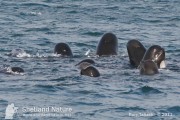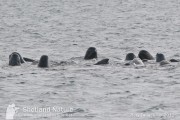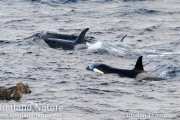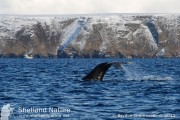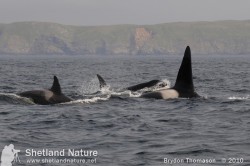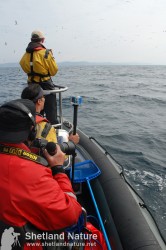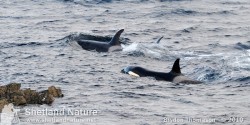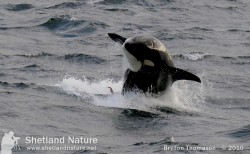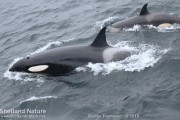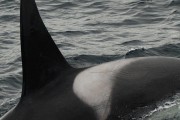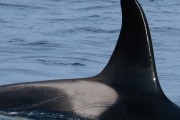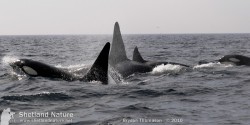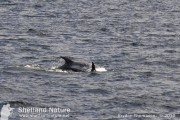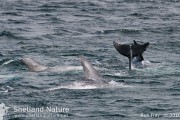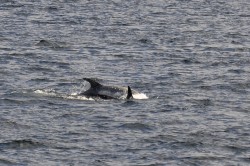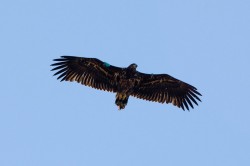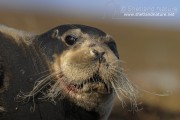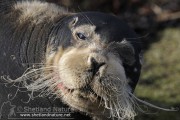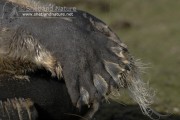Archive for the ‘Sea Mammals in Shetland’ Category:
Pilot Whales in Lerwick Harbour
Posted by Brydon Thomason on Monday 7th March 2011 | Sea Mammals in Shetland
How many times do you find yourself being told “Oh, you should have seen it…” or “Where were you? It was incredible!” Well this time I heard them all and more! Pilot Whales or Caain Whales (as they are known in Shetland) have become very rare in Shetland over the past couple of decades or more, so a pod of over twenty in Lerwick harbour caused quite a lot of excitement to say the least. Not only were they right in the harbour, just off Lerwick’s main pier, but it was also a Saturday so they could be enjoyed by even more lucky observers.
Amongst the assembled crowds were many friends, including a couple of our tour leaders, Rory Tallack and Helen Moncrieff and our web developer David Gifford (few of whom were subtle about how much I had missed out!). So where was I? About as far away as I could have been, on Unst with my mobile phone out of signal (one of the few downsides to living in the north isles)! The first I was aware of their presence was well after 09:00hrs when my phone buzzed to life with texts and voicemails, all of which were about the whales. The first of them, at 07:25, was from the crew of the Bressay, informing me of a pod of at least 20 whales or dolphins in the harbour (it’s calls like these that are crucial not only so sea mammals are hopefully identified and recorded but also so that as many people as possible get to enjoy such fabulous world-class encounters). Later another to say they were possibly Caain whales or maybe Risso’s dolphins. Amongst the other messages was one from Jonathan Wills (in the Czech Republic!) of Seabirds-and-Seals with news of the sighting. It is reassuring how quickly news gets around on sightings like these.
But Pilots were not the only whales to put in an appearance that day. Amongst the messages was a voicemail from a ferry crew on Yell Sound with news of a pod of Killer Whales! Perhaps slightly more expected, this sighting was of a pod of five and came only days after I had prompted crew members to keep their eyes peeled as we were just about bang on time for the first sighting of the season. It is very likely (although with no photos we can’t be sure) that this pod will be the same pod of five that has arrived during this early period in the spring for the last three years. Prior to last year, it comprised only four animals but arrived back with a fairly newly born calf last year. Slowly a pattern of sightings is starting to appear and especially with thanks to the work of Andy Foote and Volker Deeke of the North Atlantic Killer Whale ID project.
Late winter and early spring sea mammal sightings are in actual fact not as uncommon as you might think. Remarkably, we identified Humpback Whales on almost the same date in February exactly the same location (Bluemull Sound) two winters running, and then on the third (2010) they appeared in December. Perhaps these sightings are of the same individuals following the same route as they migrated north. All of these sightings were thanks to our local contacts being quick off the mark and calling us with their sightings, keep the calls coming!
Permalink
A round up of Killer Whale sightings in Shetland 2010
Posted by Brydon Thomason on Thursday 2nd December 2010 | Sea Mammals in Shetland
By Andy Foote, Brydon Thomason and Suzanne Beck
Even as this year draws to a close there have been killer whale sightings around Shetland. So it seems like a good time to look back at the comings and goings of our killer whales during 2010.
The first whales showed up in late March (23rd) in Yell Sound, which is consistent with the past few years. We got a chance to photograph them from the Yell Sound ferry, but the sun was working against us and the images were backlit and we couldn’t really positively ID any of the whales. One of the female-sized fin silhouettes however had two distinctive notches in the trailing edge, which looked very much like the female with ID number 12. But other individuals had silhouettes that did not match any of the fins in our photo-id catalogue, and so it seems like we had some new whales!
The new individuals appeared to stick around for a couple of weeks as the fin shapes match with those seen hunting in Scalloway harbour only days later on the 28th March and with 2 males photographed in Yell Sound on the 8th April.
May was a quiet month around Shetland, and all the action was further south. The group of four (27, 34, 72 & 73) that are regularly seen around Shetland showed up in Scapa Flow (6th May) and have a new calf! It appears as though 27 is it’s mum as it stayed closest to her in all the photos we were sent. The photo (left) of this pod was taken on Bluemull Sound on 15/03/08.
We got to follow this groups travels through a series of great photos provided by the public. On the 13th May they were seen off Durness in Sutherland, but they headed east again and were photographed on the 20th off Whaligoe steps, Ulbster, Caithness, they didn’t show up again until 23rd August when they were photographed off the Faeroes feeding on eiders and doing some hunting training with the youngsters, and even hit the headlines by making it on to the Faeroese evening news.
12 and her group were also sighted regularly in May, being photographed between Shrapinsay and Kirkwall on the 9th May, and then Duncansby Head, Caithness on 16th, they were back up to Orkney where they took a marine mammal in Eynhallow Sound on the 25th May, before heading South again, being seen back off Caithness on the 28th May, they then headed west and were last positively identified off St Kilda on 12th June. They may have also paid a fleeting visit to Shetland as a group that looked like them were photographed on 8th July off Bressay, but it was choppy weather and the photos weren’t clear enough to be sure.
Larger groups of killer whales were also getting seen feeding on herring offshore and about 25 miles east of Shetland during May. Photos we received were all of individuals not previously catalogued.
June was pretty quiet too, until on the 23rd a group of 5 showed up in Yell Sound and took either a seal or porpoise just off the ferry. This was the start of an unprecedented run of sightings from the Yell Sound ferry, with almost daily sightings for a month. Photos that we have received or collected ourselves between 23rd June and 24 July showed that most of these sightings were of the same group of 5, which were positively IDed on the 23rd June, 7th, 12th, 15th and 18th July. The group had not previously catalogued and it seems highly likely that they are newcomers to Shetland.
They weren’t the only group seen around Shetland at this time, as noted above the group on Bressay were definitely not the same group, and our old friend Bigga (ID number 14) was seen on his own off Gutcher on 10 July and again on two occasions over the following fortnight on Yell Sound.
Further South again photographs came in of the female with ID number 15 group who we last saw in 2009 off Bluemull Sound, once off the Moray Firth on the 29th June and then off Orkney on the 20th July.
So this year due to the amazing public contribution of photos, we’ve been able to track some pods as they have moved over quite a considerable distance, we’ve been able to monitor the birth of new calves, and we’ve seen what look like 2 sets of newcomers to the Northern Isles, suggesting that killer whale sightings in this area may be on the increase.
A massive thank you to everyone who contributed to this year’s efforts, the support continues to grow each summer!
Read more about the ID project at www.northatlantickillerwhales.com
Permalink
Risso’s dolphin photo ID
Posted by Brydon Thomason on Monday 16th August 2010 | Sea Mammals in Shetland
Once again, it has been a good season for encountering these fascinating dolphins. We enjoyed several encounters through out the season, one of which in early May proved to be very interesting and indeed informative.
After photographing a pod on Bluemul Sound whilst editing images I came across an individual with a very distinct scar on its left side, just bellow the dorsal. I immediately thought that this scar was familiar to me and that I had seen it on a dolphin before but couldn’t quite relate to when or where I had seen it on another animal.
It was not until some weeks later, I came across images on my laptop taken by Dr Volker Deeke (a member of the Shetland Nature team) off East Yell last summer. In his sequence he had photographed this same individual, clearly identifying it as the same animal as I had encountered.
In many ways it was no surprise to confirm a positive ID and a match (although this is the first time photo ID’s have been confirmed in Shetland), as many of us already presumed that sightings in Shetland each summer probably relate to the same pods (as is the case with returning Killer whale pods) and that these pods are probably quite faithful to particular stretches of water each year. Risso’s certainly show a preference for the waters around the North east of Shetland especially the waters around Unst, Yell, Fetlar, Skerries and Whalsay. Sightings are however recorded from other locations pretty much annually.
Jane Evans and a team of researchers from the Scottish Oceans Institute began some research on these somewhat enigmatic sea mammals this summer. Mainly working in the waters off Unst, Yell, Fetlar and Skerries more often than not they would locate the pods on a daily basis in the same areas, often using hydrophones both to locate and record the enthralling vocalisations they use to communicate under water. We look forward to their return in 2011 and giving them our continued support.
Permalink
World-class encounters!
Posted by Brydon Thomason on Friday 7th May 2010 | Birding in Shetland, News, Sea Mammals in Shetland
What a fantastic day! After an extremely successful (and very enjoyable) three days of Otter Photography – 23 Otters on three Islands with a Dutch client (Wim Konninghurst) we decided to spend a day on Unst.
The day got off to a fantastic start with a pod of over 20 Risso’s Dolphins off the early morning ferry. The dolphins were spread widely across Bluemull Sound between Yell and Fetlar. This stretch of water is one of the best in the Isles for seeing these burly dolphins.
Although you cant quite make out much detail from my cropped record shots, Risso’s are characteristically covered in scars. With blunt- bow headed appearance and these often rather prominent markings, Risso’s can look quite coarse and rather rough looking and with this be very distinct, given decent views. They are often quite deep water predators, with squid being a favourite food source and cause of much of the scarring! Feeding dives can often last up to an impressive 15-20 minutes and Squid in the stomach contents of Risso’s have been found to measure an amazing 12 feet! Lets hope we manage to locate them during our Seamamal Search on the 29th of May!
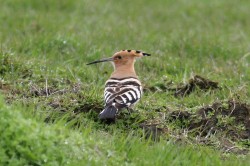
Barely an hour later, on arrival to Burrafirth Shore Station at the North end of Unst (where the Scottish Natural Heritage reserve’s visitor centre is based) we found a Hoopoe, literally seconds after getting out of the car and kitted up! Quite increadable given that fellow members of the ‘Shetland Nature’ team Garry Bell and Rob Fray had been called out to identify a bird the previous day – which turned out to be a Hoopoe! Which incidentally is the one photographed, by Gary.
But the day was not yet done. Just as we were about to make our way down off the reserve, whilst sitting gazing out over the Atlantic Ocean, simply awe struck by the ‘seabird city’, my good mate Robbie Brooks rang to inform me he had just had a Sea Eagle heading North over his house. Trying not to expect too much more out of what had already been an incredible outing, I thought to myself ‘that could very probably head our way…’
I then also passed on the exciting news by calling the reserve warden Alister Wilson, who I knew was out on the reserve, not too far away.
Sure enough about an hour later we were alerted to the birds presence by the hundreds of Great Skuas which took to the air across the reserve as the bird drifted low over the moorland. A truly awesome sight indeed watching how this fantastic bird of prey simply dwarfed the swarming Skuas. Not wanting Alister to miss out I called him again literally minutes later it soared over his head, when he got this cracking shot- note the wing tag.
The bird was an immature which was first seen a few weeks earlier on Fair Isle and again by good friend and Shetland nature tour leader Roger Riddington soon after. It is one from a release program on the east coast of Scotland. This bird had a green wing tag on with a No.8 on and is known to be a one year old male. We later enjoyed yet another encounter with the bird during an evening visit to the reserve cliff tops.
Oh if only these masterful raptors would return to the Isles to breed some day…
Permalink
Spring cetacean specials
Posted by Brydon Thomason on Saturday 17th April 2010 | Sea Mammals in Shetland
Spring cetacean specials indeed! April really is shaping up to be quite a month for sea-mammals and not just the exhilarating Orca! After my first encounter on the 23rd of March I was favoured by fortune not just once but twice in four days with close encounters with Killer whales.
Once again, Yell Sound (the channel between Shetland Mainland and the Island of Yell) was the place to be. Two of the bulls, which I recognised from the sighting in March made their way rather effortlessly North with the ebe tide. This really was something I thought to myself, two sightings in just a couple of weeks and so early in spring. It is usually well into May/June before Orca sightings begin to ‘heat up’. Then only four days later, on the 12th, the same two bulls accompanied with eight or more whales (the same pod from the March sighting) traveled South through Yell Sound. What was even more exciting is that at this same time there was an additional three whales heading in the same direction across on the other side of the sound, which I would assume to part of the same ‘super pod’.
What was probably the same pod of 10 or more, was seen moving South off Sumburgh Head on the 15th- the circumnavigation of our Isles by these enthrawling sea-mammals continues…
As if the Killer whale encounter had not been enough excitement, we were also enjoyed a pod of at least six Risso’s dolphin on the 9th (yes- in between the Orca encounters!).
Permalink
Bearded Seal
Posted by Brydon Thomason on Monday 5th April 2010 | Sea Mammals in Shetland
The start of the year began just as it had ended, with the continuing, crisp, snowy spell of weather across Shetland and indeed, most of the United Kingdom. I was eagerly optimistic that our Isles could well be graced with an exotic Arctic visitor, maybe a Ross’s gull, Gyrfalcon or Snowy owl. My mind drifted back to last winter’s delightful Ivory Gull, which I discovered on my native Island of Fetlar. Shetland can be such an exciting place at any time of the year!
Then on the 4th of January I received a phone call from Ian Nicholson of Aywick, Yell telling me of an ‘unken’ (unusual) seal hauled out on a grassy bank right up at the head of the Mid Yell Voe. It seemed that a visitor from the Arctic was to be in ‘flippered’ not feathered form! Although not certain, but having seen one over a decade before on the exact same bank, Ian was fairly sure it was a Bearded Seal. Fortunately along with my wife Vaila and two month old son Casey, I happened to be on the island of Yell at the time, just about to board the ferry to Fetlar from Gutcher! Needless to say we rapidly pulled out of the queue of cars and did an about turn! Knowing Ian’s keen eye for sea mammals and having waited many years to connect with this very rare visiting Arctic seal, obviously, we wasted no time and went straight there.
On arrival a quick scan along the bank Ian had directed us to immediately revealed the seal, still hauled out on the snow-covered bank. It was indeed a Bearded and a wonderfully authentic encounter for us as we enjoyed our first ever Bearded seal as the snow flakes fell all around us. Given the weather conditions and landscape, it could just as easily have been Svalbard or the Canadian Arctic we were in, and for a moment it felt like it was!
This record represents the 12th occurrence of this very rare visitor from the Arctic in Shetland, and the third for Mid Yell. It was first recorded in the Isles in 1956. The most recent sighting was in 2007 but unfortunately after its identity was confirmed, news of the seal’s weeklong stay was not released. On this occasion we released the news immediately and therefore this year’s animal has delighted many observers since and has been regularly reported on Birdguides. It was still present at the time of writing. Incredibly another visited Orkney at the same time.
Away from Shetland there are a mere handful of records with fewer than half a dozen sightings since it was first recorded in England in 1892. It has only reached the shores of Ireland on one occasion.
Across the Arctic where it has a fairly widespread distribution it is a primary food source of the Polar Bear and also for much of the Inuit people living traditionally along the Arctic coasts. They can reach up to 2.7m in length and weigh up to 340kg when fully grown. Unlike most seals, there is little or no difference the size of males and females. The majority of food is found on the sea- bed, where they use there charismatically long whiskers to sense and feel for food, which consists mainly of squid, clams (and other shellfish) and fish at depths of 450m or more.
So what does next winter have in store, personally I am praying for a male Walrus. But the fascination of wildlife watching here means every day is different, we’ll never know until it happens!
Permalink
Killer Whales on Yell Sound 23rd March
Posted by Brydon Thomason on Monday 29th March 2010 | Sea Mammals in Shetland
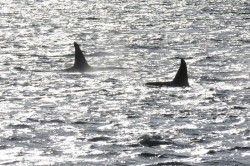
Our third encounter of the year! Spotted on Yell Sound off the ferry, Brydon had his first encounter of the year (the second for Shetland Nature in just a couple of weeks and its not even April yet!).Managing to get some ‘record shots’ of at least six of the pod, Brydon recognised three of the animals as previously recorded and regular visitors to Shetland. In conjunction with Andy Foote and Volker Deeke (North Atlantic Whale ID Project/ Scottish Killer Whale Identification Research Team), we were able to piece together a fairly well informed but perhaps speculative picture of how many animals were in the pod (based on the pod sizes that the identified animals are typically seen with).
There was obviously a minimum of six whales seen at any one time but we, (along with other lucky observers) were almost certain that there may well have been as many as double that, given how well spread out the pod seemed to be.
Individuals 012 and 015 were both positively identified, these are regular visitors to Shetland and have been sighted almost annually in recent years; 012, who normally travels in a pod of 5-7, (013 was also thought to have been matched who also travels with this same group). She was not reported off Shetland last year but was however identified off Orkney in May. Other confirmed sightings of this individual have come from St Kilda in 2006 and off Iceland in 1999. 015, a female that was part of a large pod Andy, Volker and Brydon encountered last July off Unst. In recent years this individual has been photographed with her pod off Fair Isle, Wick and Orkney. It is very likely that this pod (of up to 10 animals), or at least some of this pod were among this sighting.
A bull in the pod showed a very similar dorsal mark to that of a very familiar and regularly encountered bull in Shetland, known as Bigga. This potentially new bull shows an almost identical dorsal mark to one from the Iceland ID catalogue, who was photographed there in 1986! With out better images of each individual however, we can not be certain.
If the positively Id’d whales were travelling with their regular respective pods, there could well have been up to 12-15 animals travelling together. It is with thanks to the outstanding and on going work carried out in the Shetland waters and beyond by Andy, Volker and their colleagues that we are slowly building a clearer picture of these awe inspiring sea-mammals.
We are very much looking forward to another season of working closely with the research team and feel privileged to have Andy and Volker working with us as tour leaders and guides.
To find out more about the ID and research visit http://www.northatlantickillerwhales.com/ or http://www.smru.st-andrews.ac.uk/
Permalink
Early Orca for third year running
Posted by Brydon Thomason on Saturday 6th March 2010 | Sea Mammals in Shetland
For the third year running Killer whales have put in an early spring appearance. What is even more interesting is that the pod of 3/4 seen off Lerwick on the 5th March is very likely to be the same pod of four which have been seen and photographed heading North, almost to the day, late February and early March. The pod of four have been documented and numbered by the Scottish Killer Whale Identification Research Team (North Atlantic Killer Whale Project). Andy Foote of the Research team, who also leads our sea mammal search, said yesterday – “The pod consists of animals numbered 27, 34, 72 & 73 and were also photographed off Faroe last April, which would perhaps tie in with their sightings moving North such as this years. 34 is the sub-adult male, his dorsal fin had just started to sprout last year, so he is probably about 14-15 years old, he might look quite different this year as he is likely to have grown a bit and his fin to have got taller. The last time they were seen was on 28 June last year off the Shetland mainland”.
Update: Remarkably they reappeared on Sunday when one of our tour leaders, Roger Riddington, saw them off Sumburgh Head.
Permalink


